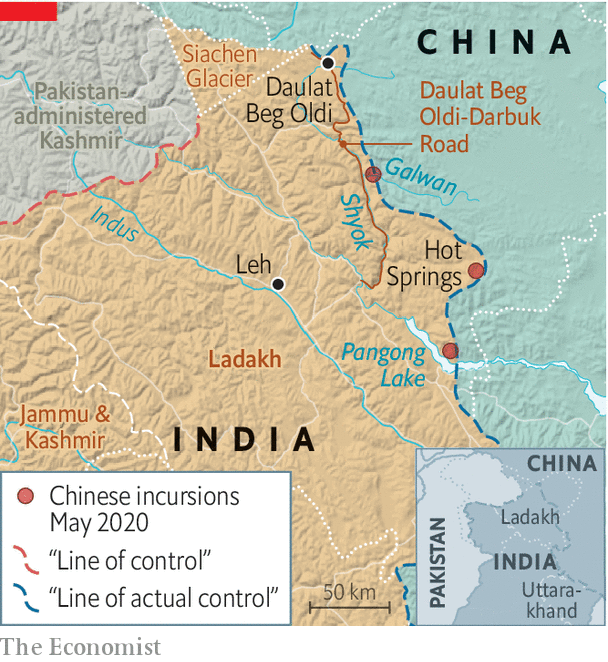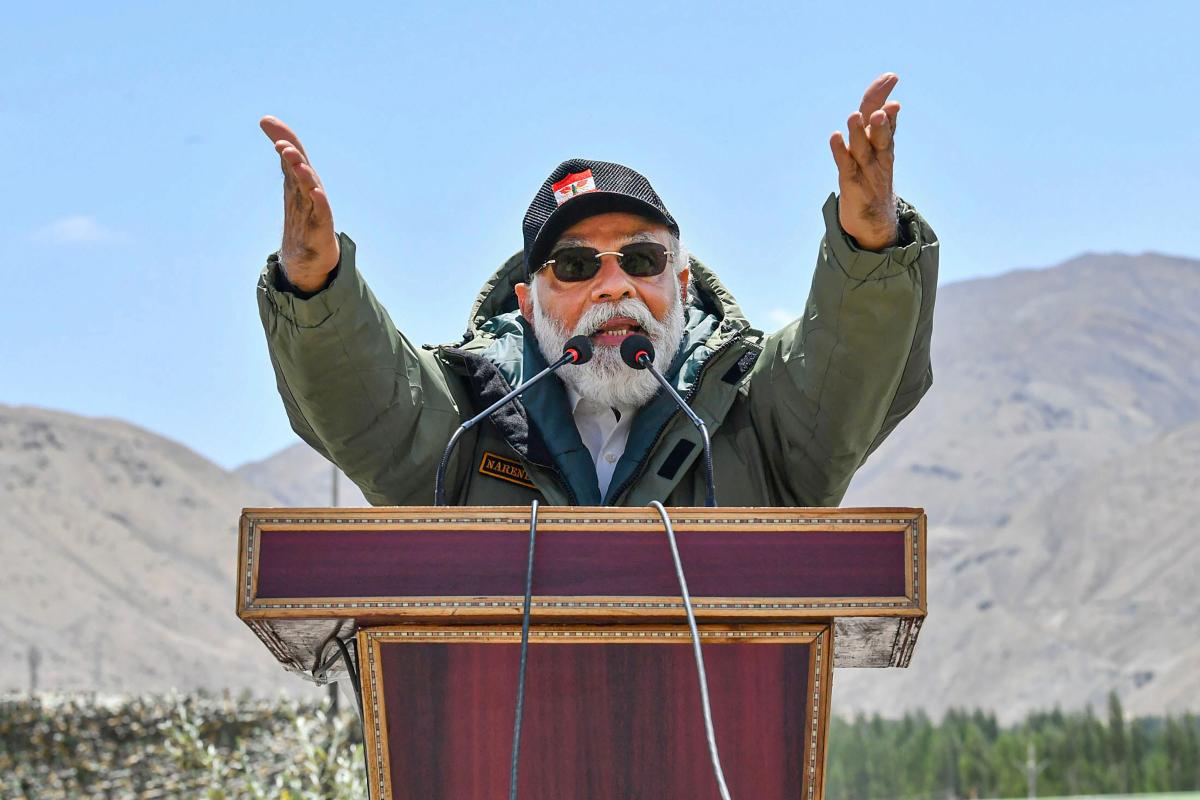PM Modi has to deliberate if, willy-nilly, he has followed Jawaharlal Nehru’s course, with regard to China.
By Nilanjan Mukhopadhyay. First Published in The Quint on 06 Jul 2020.
Snapshot
- Modi was, in a sense, performing two dissimilar roles simultaneously.
- The first, his political side, primarily addressed his electoral wards who were feeling a tad let down at perceived ‘inaction’ (against China).
- Word-crafting and delivering statements packed with an appropriate dose of mythology and poetry is Modi’s favourite playground. His speech was efficiently sequenced.
- The second dimension of the Modi persona on display in Nimu was in his prime ministerial role.
- In this capacity, he relayed messages not just to the Chinese political and military leadership, but also to the global community.
Without doubt, Prime Minister Narendra Modi’s visit to Ladakh and address from Nimu, the Headquarters of 14 Corps, was not mere symbolism. Instead, it delivered diverse messages for the armed forces, the citizens of India, the international community, and finally, the Chinese political and military leadership.
The carefully-worded speech, telecast live, thereby converting it into a virtual address to the nation, was principally aimed at shoring up his political constituency, besides propping up the morale of armed forces.
Insofar as the Chinese leadership is concerned, who will undoubtedly essay a decisive role in ‘resolving’ or ‘escalating’ the current standoff, Modi used words that – while sounding like music to domestic supporters – kept a diplomatic door open by NOT naming China in his utterances.
Modi’s Two ‘Dissimilar’ Roles
Modi was, in a sense, performing two dissimilar roles simultaneously. The first, his political side, primarily addressing electoral wards who were feeling a tad let down at perceived ‘inaction’, and with the PM’s muddled statement while concluding the all-party meeting – which needed post-facto clarification by the PMO.
His response to the violent confrontation on 15/16 June was considered as being in complete contrast to Modi’s actions post Uri and Pulwama, which had created the narrative of a ‘Modi way’ of securing India, distinct from any of his predecessors.
This was the demographic section that needed to be assured that the fabled ‘56 inches chest’ had not shrunk – that he carried the same ‘fire and fury’, also the moniker of the 14 Corps, whose cap he consciously donned.
After having given ammunition to his corps of admirers to wage battles on social media and television, Modi spent time bolstering the confidence of the serving troops, and their families back home.
Modi’s Leh Speech Was Efficiently Sequenced
Soldiers do not require pep-talks from politicians, especially because they enter the force with resolve that is unmatched in the political terrain. But, a few words in praise, especially on occasions when they are stressed and have lost comrades, perhaps due to tactical error, will never go abegging.
After having given ammunition to his corps of admirers to wage battles on social media and television, Modi spent time bolstering the confidence of the serving troops, and their families back home.
Modi was, in a sense, performing two dissimilar roles simultaneously.
The first, his political side, primarily addressed his electoral wards who were feeling a tad let down at perceived ‘inaction’ (against China).
Word-crafting and delivering statements packed with an appropriate dose of mythology and poetry is Modi’s favourite playground. His speech was efficiently sequenced.
The second dimension of the Modi persona on display in Nimu was in his prime ministerial role.
In this capacity, he relayed messages not just to the Chinese political and military leadership, but also to the global community.
Modi’s Leh Speech Was Efficiently Sequenced
Soldiers do not require pep-talks from politicians, especially because they enter the force with resolve that is unmatched in the political terrain. But, a few words in praise, especially on occasions when they are stressed and have lost comrades, perhaps due to tactical error, will never go abegging.
Word-crafting and delivering statements packed with an appropriate dose of mythology and poetry is Modi’s favourite playground. His speech was sequenced efficiently, and conveyed how the soldiers’ courage and conviction enabled citizens to gain confidence to pursue the objective laid out by Modi – ‘atmanirbharta’ or ‘self-reliance’.
This is the ‘Modi-standard’ – everyone is part of a bigger and ‘national’ project as envisioned by him.
Soldiers fight not just on battle grounds, but provide strength to people engaged in the economic, social or other arenas. Vice-versa, those not in the armed forces work to transform the nation into an object of global envy, in turn enhancing the pride and self-respect of the armed forces. This is the way it should be universally, but Modi has, by dint of communication and legwork, secured exclusive rights to this narrative.

Modi’s Reiteration Of ‘Traditional Indian Duality’
The second dimension of the Modi persona on display in Nimu was in his prime ministerial role. In this capacity, he relayed messages not just to the Chinese political and military leadership, but also to the global community.
The first of two most internationally significant assertions was the reiteration of the traditional Indian duality: that of the flute-playing playful people, contrasting with vengeance-seekers who are not shy to use new technology for warfare.
This was no threat, but Beijing will keep this declaration in mind when considering its next step.
The other important postulation was the contention that the world is divided between those pursuing vikaasvaad or development, and others singularly chasing vistaarvaad or expansionism. For a nation with unresolved territorial issues with China and Pakistan, and now Nepal too, the second half of this proposition does not say that the Beijing leadership is ‘expansionist’ as it could be directed at others.
But, it should not be ignored that in public discourse in democracies, ‘context’ is of vital import, just as exaggerations or filibusters.
But, in the syllable-specific world of diplomacy, Modi’s decision to talk either in similes or in the third person, provides an option of retreat and is useful when negotiating the fine-print.
Modi Supporters Received A Shot In the Arm, But The Way Ahead Remains Daunting
The prime minister not just messaged the international community regarding the value Ladakh holds for the rest of India – by terming the region as the nation’s ‘forehead’ – but he also spoke on their behalf. It would have been with due thought and after adequate conversations that he asserted, “poore vishwa ne vistaarvaad ke khilaf man baya liya hai” (the entire world has made up its mind against the tenet of expansionism).
The prime minister’s supporters may have received a shot in the arm with this visit and address, but the way ahead remains uncertain and daunting.
Modi’s legacy will be assessed through the prism of developments in 2020, chiefly the COVID-19 pandemic and the state of affairs with China. With the pandemic continuing to test his image of an able administrator, the situation in Ladakh has the capacity to deflate the aura of Líder Máximo or Maximum Leader, that he had assiduously raised.
In search of global acceptance and admiration, just as several of his predecessors had, he pursued personalised diplomacy, which certainly didn’t cause a flutter in Xi Jinping’s heart.
In September 2014, during his first visit to Japan, Modi flagged the issue of expansionism rearing its head once again.
The statement was made barely a fortnight before Xi Jinping’s visit to India, when Modi received him in Ahmedabad and choreographed an evening on the banks of the Sabarmati (a day that was also Modi’s birthday).
This dissonance between assertion and action has dogged Modi’s China policy.
Modi Needs To Do More Than Just Shore Up The Domestic Constituency
Although aware of Beijing’s territorial ambitions over India, he allowed the notion of civilizational and personal connect to cloud his judgement. Not content with flaunting in May 2015, during his China visit, the “extraordinary personal relationship” with the Chinese premier, Modi repeated it to cheering crowds in Gujarat in 2017.
Modi has to deliberate if, willy-nilly, he has followed Jawaharlal Nehru’s course.
India’s first premier, Nehru, wrote to chief ministers in October 1959, that “India and China have fallen out”. He was aware of the “Chinese State, expansive and pushing out in various directions”. Yet, he remained on course, to meet his nemesis in 1962. The choices before Modi are limited now, and just shoring up the domestic constituency may not be enough. What options are available is, however, a different matter.
Disclaimer: The opinions expressed within this article are the personal opinions of the author. AlignIndia does not take any responsibility for the content of the article.
Nilanjan Mukhopadhyay is an author and journalist based in Delhi. He has authored the book ‘The Demolition: India at the Crossroads’ and ‘Narendra Modi: The Man, The Times’. He can be reached @NilanjanUdwin.


